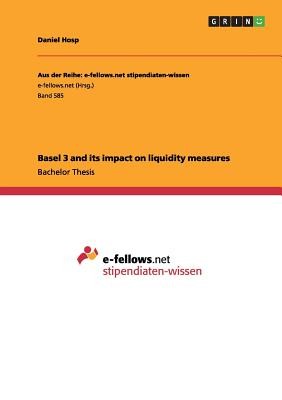
- We will send in 10–14 business days.
- Author: Daniel Hosp
- Publisher: GRIN Verlag
- ISBN-10: 3656327769
- ISBN-13: 9783656327769
- Format: 14.8 x 21 x 0.4 cm, softcover
- Language: English
- SAVE -10% with code: EXTRA
Reviews
Description
Bachelor Thesis from the year 2011 in the subject Business economics - Investment and Finance, grade: 1, University of Innsbruck (Banken und Finanzen), language: English, abstract: 1. Introduction On 6 September 2009 the Central Bank Governors and Heads of Supervision agreed on Basel III after the financial crisis proved that Basel II was not capable of preventing the global economy from such a crisis (BCBS, 2008). Basel III is the third version of the international regulatory framework for financial institutions published by the Basel Committee of Banking Supervision (BCBS) of the Bank for International Settlements (BIS) located in Basel, Switzerland (BIS, www.bis.org, 30.04.2011).... .... This bachelor thesis should provide some deeper information about the impacts of the new liquidity measures. The impact of the standards on economy, financial institutions and their business segments is presented, after a detailed explanation of them. Concluding a comprehensive evaluation of the new requirements is done. 2. Developments in Basel III 2.1. Increasing Capital Requirements 2.2. Liquidity Coverage Ratio 2.3. Net Stable Funding Ratio 2.4. Monitoring Tools and Application of Standards 3. Initial Situation of Banks Regarding Liquidity Requirements 3.1. Quantitative Impact Study of the BCBS 3.2. European Quantitative Impact Study of the CEBS 3.3. Comparison of Results 4. Economic Impacts of the New Liquidity Requirements 4.1. Benefits of the New Liquidity Requirements 4.2. Costs of the New Liquidity Requirements 4.3. Evaluation of the Results 5. Impact of the Liquidity Requirements on Banks and their Business Segments 5.1. Changed Market Conditions 5.2. Impact on the Profitability of Banks 5.3. Impact on Business Segments 5.4. Impact on Central Banks 5.5. Overall Impacts on Banks and Business Segments 6. Evaluating the Liquidity Rules of Basel III 6.1. Static Nature of the Liquidity Measures 6.2. Are Wrong Incentives the Actual Causer? 6.3. Introduction of Basel III
EXTRA 10 % discount with code: EXTRA
The promotion ends in 15d.17:54:50
The discount code is valid when purchasing from 10 €. Discounts do not stack.
- Author: Daniel Hosp
- Publisher: GRIN Verlag
- ISBN-10: 3656327769
- ISBN-13: 9783656327769
- Format: 14.8 x 21 x 0.4 cm, softcover
- Language: English English
Bachelor Thesis from the year 2011 in the subject Business economics - Investment and Finance, grade: 1, University of Innsbruck (Banken und Finanzen), language: English, abstract: 1. Introduction On 6 September 2009 the Central Bank Governors and Heads of Supervision agreed on Basel III after the financial crisis proved that Basel II was not capable of preventing the global economy from such a crisis (BCBS, 2008). Basel III is the third version of the international regulatory framework for financial institutions published by the Basel Committee of Banking Supervision (BCBS) of the Bank for International Settlements (BIS) located in Basel, Switzerland (BIS, www.bis.org, 30.04.2011).... .... This bachelor thesis should provide some deeper information about the impacts of the new liquidity measures. The impact of the standards on economy, financial institutions and their business segments is presented, after a detailed explanation of them. Concluding a comprehensive evaluation of the new requirements is done. 2. Developments in Basel III 2.1. Increasing Capital Requirements 2.2. Liquidity Coverage Ratio 2.3. Net Stable Funding Ratio 2.4. Monitoring Tools and Application of Standards 3. Initial Situation of Banks Regarding Liquidity Requirements 3.1. Quantitative Impact Study of the BCBS 3.2. European Quantitative Impact Study of the CEBS 3.3. Comparison of Results 4. Economic Impacts of the New Liquidity Requirements 4.1. Benefits of the New Liquidity Requirements 4.2. Costs of the New Liquidity Requirements 4.3. Evaluation of the Results 5. Impact of the Liquidity Requirements on Banks and their Business Segments 5.1. Changed Market Conditions 5.2. Impact on the Profitability of Banks 5.3. Impact on Business Segments 5.4. Impact on Central Banks 5.5. Overall Impacts on Banks and Business Segments 6. Evaluating the Liquidity Rules of Basel III 6.1. Static Nature of the Liquidity Measures 6.2. Are Wrong Incentives the Actual Causer? 6.3. Introduction of Basel III


Reviews